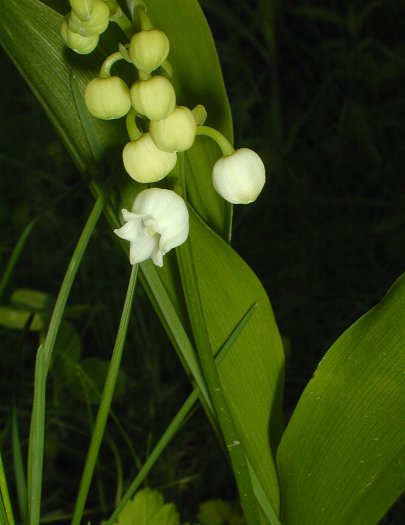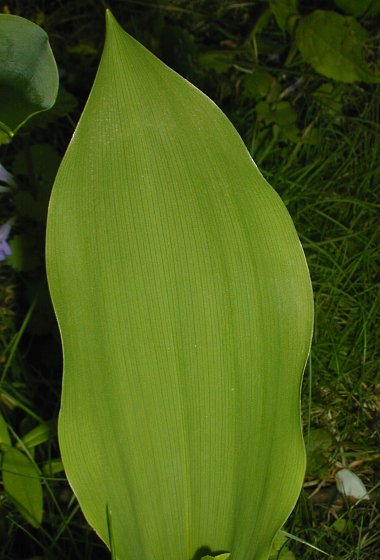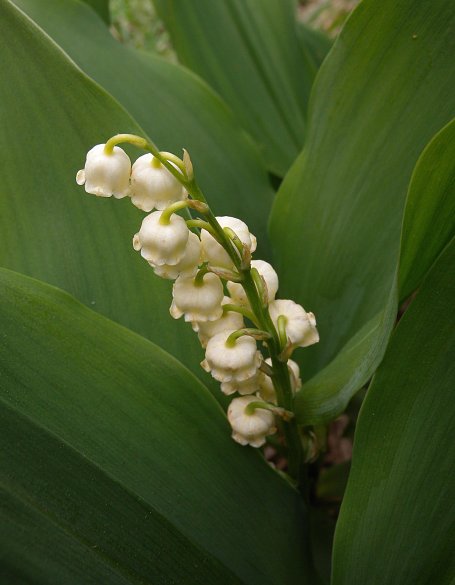Description: This perennial herbaceous plant consists of a pair of leaves that are nearly basal and a single raceme of flowers. The leaf blades are 5-10" long, 3-5" across, and more or less erect; they are oval-ovate in shape and smooth (entire) along their margins. Both the lower and upper leaf surfaces are medium to dark green, glabrous, and sometimes slightly glaucous. Leaf venation is parallel. The leaves taper into petioles about 1½–3" long that wrap around a short basal stalk that is partially underground. Between the leaves, there develops a raceme of flowers about 4-9" long. This raceme is shorter than the leaves and it tends to nod toward its apex; there are 6-16 flowers per raceme. The central stalk of the raceme is medium green, terete, somewhat slender, and glabrous. The nodding flowers usually occur along one side of the raceme from pedicels that are up to ½" long; these pedicels are light green, terete, and glabrous. At the bases of these pedicels, there are solitary floral bracts. These floral bracts are up to 8 mm. (1/3") long, light green to nearly white, and narrowly lanceolate to ovate in shape; they are shorter than the corresponding pedicels.

The white corollas of these flowers are about 8 mm. (1/3") long and similarly across; they are campanulate (bell-shaped) with 6 short lobes that curve outward. Within the corolla of each flower, there are 6 stamens with short filaments and a single style with a tripartite stigma. The ovary of each flower has 3 cells. The blooming period occurs from late spring to early summer, lasting about 3 weeks. The flowers are quite fragrant. When the flowers are successfully cross-pollinated from the pollen of genetically distinct plants, they develop red berries that are 6-8 mm. across and globoid in shape (one berry per fertile flower). The interior of each berry is juicy, containing 1-6 seeds. These seeds are 3-4 mm. long and light brown with darker scar tissue at their bases; they are more or less ovoid in shape, but also rather irregular and chunky. In North America, most flowering plants fail to produce berries. The root system is fibrous and rhizomatous. Dense colonies of clonal plants are produced from the dense network of rhizomes; these colonies tend to exclude other species of plants.

Cultivation:
The preference is dappled sunlight to medium shade, moist to mesic
conditions, and a rich loamy soil with abundant organic material. Once
it becomes established, this
plant is long-lived, and it will spread slowly via its rhizomes. The
leaves remain green throughout the summer until frost occurs during the
autumn. Propagation of new plants is easiest by division of the
rhizomes. If you want Lily-of-the-Valley to produce the attractive red
berries, then you will need to plant genetically distinct plants in
proximity to each other from two or more sources.
Range & Habitat:
Lily-of-the-Valley has escaped from cultivation primarily in NE
Illinois (see Distribution
Map), where it is uncommon in natural areas. This species was
introduced into the United States from Europe as an ornamental plant;
it is often grown in gardens because of the attractive foliage and
flowers. In addition to the typical European variety that is
described here (Convallaria
majalis majalis), there is also a North
American variety of
Lily-of-the-Valley (Convallaria
majalis montana) that is native to the
region of the Appalachian mountains. However, this North American
variety is cultivated much less often than the European variety of
Lily-of-the-Valley, and it has not naturalized in Illinois to anyone's
knowledge. In Illinois, the European variety of Lily-of-the-Valley has
naturalized in such habitats as tamarack bogs, rich deciduous
woodlands,
pioneer cemetery prairies, oak savannas near pioneer cemetery prairies,
and abandoned
homestead sites. At some of these habitats, Lily-of-the-Valley was
deliberately introduced, where it has persisted for several decades,
notwithstanding long neglect.

Faunal Associations: Bumblebees and honeybees collect pollen from the flowers of Lily-of-the-Valley; nectar may not be produced (Vandepitte, 2010; Müller 1873/1883). Among bumblebee species, Bombus vagans and Bombus pensylvanicus have been observed to visit the flowers (Mathews, 1912). Insects that feed on the foliage and other parts of this plant are limited in number. An insect that was accidentally introduced into North America from Europe, Lilioceris lilii (Lily Leaf Beetle), feeds on the leaves, while an aphid, Macrosiphum pechumani, sucks sap from this plant (Clark et al., 2004; Blackman & Eastop, 2013). The red berries probably attract birds and possibly some rodents, although because these berries are rarely produced in North America, it is unknown which species would consume them. According to Eriksson (1999), the seeds of these berries are eaten by voles and wood rats in Europe. Because all parts of Lily-of-the-Valley contain cardiac glycosides that are toxic, it is largely ignored by mammalian herbivores. Overall, the ecological value of this plant appears to be low.

Photographic
Location:
A wooded area at Meadowbrook Park in Urbana, Illinois, and a flower
garden in the same city.
Comments:
In addition to its cultivation in gardens, Lily-of-the-Valley has
economic significance in the perfume and pharmaceutical industries. For
the latter, it has been used as a source of heart medication. There are
two varieties of Lily-of-the-Valley: the typical European variety (Convallaria majalis majalis)
and the North American variety (Convallaria
majalis montana). This latter variety can be distinguished
by its larger floral bracts (at least 10 mm. in length)
and the fine green lines along the midribs of its tepals (the tepals
have been joined together to form a bell-shaped corolla for each
flower). As compared to the European variety, the North American
variety also appears to be less aggressive in forming large dense
colonies of clonal plants.